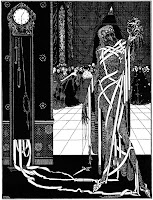10.11.2009
Gusev, Anton Checkov
 He went rapidly towards the bottom. Did he reach it? It was said to be three miles to the bottom. After sinking sixty or seventy feet, he began moving more and more slowly, swaying rhythmically, as though he were hesitating and, carried along by the current, moved more rapidly sideways than downwards.
He went rapidly towards the bottom. Did he reach it? It was said to be three miles to the bottom. After sinking sixty or seventy feet, he began moving more and more slowly, swaying rhythmically, as though he were hesitating and, carried along by the current, moved more rapidly sideways than downwards.After that another dark body appeared. It was a shark. It swam under Gusev with dignity and no show of interest, as though it did not notice him, and sank down upon its back, then it turned belly upwards, basking in the warm, transparent water and languidly opened its jaws with two rows of teeth. The harbour pilots are delighted, they stop to see what will come next. After playing a little with the body the shark nonchalantly puts its jaws under it, cautiously touches it with its teeth, and the sailcloth is rent its full length from head to foot; one of the weights falls out and frightens the harbour pilots, and striking the shark on the ribs goes rapidly to the bottom.
Overhead at this time the clouds are massed together on the side where the sun is setting; one cloud like a triumphal arch, another like a lion, a third like a pair of scissors. . . . From behind the clouds a broad, green shaft of light pierces through and stretches to the middle of the sky; a little later another, violet-coloured, lies beside it; next that, one of gold, then one rose-coloured. . . . The sky turns a soft lilac. Looking at this gorgeous, enchanted sky, at first the ocean scowls, but soon it, too, takes tender, joyous, passionate colours for which it is hard to find a name in human speech.
Harry Clarke Illustrates Edgar Allan Poe

Harry Clarke was an Irish stained-glass artist and illustrator 1889-1931. I feel that his stained glass techniques influence his drawing style, but maybe that's just me. The illustrations below are from Edgar Allan Poe's Tales of Mystery and Imagination, "The Masque of the Red Death" and "The Cask of Amontillado":


Hector and Andromache

De Chirico painted surealist scenes in the early 1900s. What they lack in realism and movement they make up for in emotion and apprehension. Below are excerpts from his writings:
“I remember one vivid winter’s day at Versailles. Silence and calm reigned supreme. Everything gazed at me with mysterious, questioning eyes. And then I realized that every corner of the palace, every column, every window possessed a spirit, an impenetrable soul. I looked around at the marble heroes, motionless in the lucid air, beneath the frozen rays of that winter sun which pours down on us without love, like perfect song. A bird was warbling in a window cage. At that moment I grew aware of the mystery which urges men to create certain strange forms. And the creation appeared more extraordinary than the creators."--De Chirico
“The Architectonic Sense in Ancient Painting” published by Chirico in 1920, confesses:
“The angels conceal secrets, and the work of art is no longer (…) limited by the acts of the figures represented, but is the entire cosmic and vital drama which envelopes man and constricts him within its spirals, in which past and future are confused, in which the enigmas of existence, sanctified by the breath of art, strip off the tangled and fearful aspects that man imagines beyond art to restore the eternal, tranquil and consoling aspect of the structures that are created by genius.”--De Chirico
Astrolabe
Javier Marin, Escultor
 I discovered Javier Marin's sculpture in Milan, 2009. His sculptures of human figures are lyrical and expressive, an amalgamation of Western tradition and Mexican culture. His pieces are an admixture of disparate elements, contrasting classical subjects, poses, and materials (bronze) with unconventional, rough surfaces and cheap industrial materials (resin, iron).
I discovered Javier Marin's sculpture in Milan, 2009. His sculptures of human figures are lyrical and expressive, an amalgamation of Western tradition and Mexican culture. His pieces are an admixture of disparate elements, contrasting classical subjects, poses, and materials (bronze) with unconventional, rough surfaces and cheap industrial materials (resin, iron).“He returns cynically to the origin of classic sculpture and from there he corrupts it immediately in a mannerist way. He is not political nor conceptual, he could even be accused of being trivial and apparently conventional. He did not chose to do “what is expected” from a contemporary artist.
(…) It is the resistance of matter to the controlled effort of the artist’s hands. It is the energy that generates a torsion in Marin’s characters and makes us go around them, as if we were part of the art work. Its effect is similar to the arrival of puberty when the senses awake and are exalted with the least provocation.”
–Agustin Arteaga, art critic.
I would like, through my work, to be able to
touch people deeply, to create a reflection of the things
that “do not exist for them,” to discover things and make
others discover places they have
not been able to reach
by themselves.
Perhaps these are aspirations of fantasy,
but what would one do if there were no more dreams? --Javier Marin
Nick Bantock, Prints and Paintings

Nick Bantock is a northwestern artist/author/businessman, whose combines collage, painting, and printmaking. I admire his use of narrative, the surreal, and the philisophical to create rich worlds on paper. His most famous work is the Griffin and Sabine series; his prints for the Canterburry Tales are here: http://www.nickbantock.com/Canterbury_Tales/CT_gallery.html
Subscribe to:
Comments (Atom)













